An American Gardener Working in Paris
How did Mark Rudkin, a former singer from Connecticut, end up designing the most splendid gardens in and around Paris?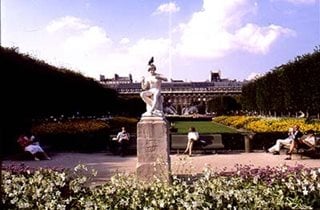
Photo by: Allison Harris.
Cardinal Richelieu built the Palais Royal in the heart of Paris almost 400 years ago. Louis XIV lived there as a young man, and the Dukes of Orléans called it home. Today it houses offices of France’s Ministry of Culture. It is more than just a monumental building, then: It is a piece of French history. Yet in 1992, when the French government decided to restore the palace’s once-famous gardens — which had been a lively Parisian meeting place in the 18th and early 19th centuries but had been largely abandoned in modern times — Culture Minister Jack Lang gave the commission not to a French designer or landscape architect but to Mark Rudkin, a transplanted New Englander with no formal horticultural training.

Photo by: Allison Harris.
Rudkin’s approach was simple: “I thought, The shape’s good, the proportions are good, but there’s no place for people to walk into the gardens and sit down.” Reviving the basic plan of 1730, with its double line of arching linden trees and its central fountain, Rudkin added four plant-framed paved enclosures surrounded by raised beds of fragrant annuals — mostly heliotrope and white flowering nicotiana. He also installed park benches, turned to face each other like seats in a railway compartment — fostering a sense of collusion among visitors. “Before I came in,” says Rudkin, “no one set foot in the place. Now people who live nearby are beginning to complain about the crowds.”
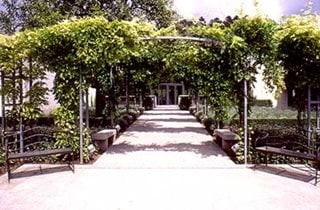
Photo by: Allison Harris.
If he has no formal training in his chosen field, Rudkin is not exactly self-taught. He grew up on a 125-acre estate in Fairfield, Connecticut, where, as he puts it, “we were all very plant-conscious. My father had a vast knowledge of trees and shrubs, and my mother did the flower garden, so I was just brought up in that element.” (His mother, Margaret Fogarty Rudkin, also happened to found a business selling home-baked whole-wheat bread and built it into a corporation named after the family’s estate —Pepperidge Farm.) His road to professional garden design was hardly a straight one, though. Now in his 70s, Rudkin has led an unusual life. As a young man he wanted to be a singer — before concluding that he didn’t have, “the right kind of sound.” In the early 1950s he hung out with artists like Jackson Pollack and Mark Rothko in New York City and developed into an accomplished painter himself. Then he became entranced by Martha Graham, studied dance with her, and toured Europe with her company in 1954. When the troupe arrived in Paris, Rudkin fell in love with the city and stayed behind when Graham returned to New York.
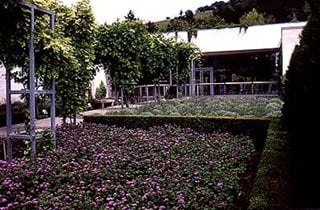
Photo by: Allison Harris.
He spent the next dozen years or so “hanging out” some more, he says, with people like Cathérine Deneuve, Paloma Picasso, and George Cukor. Then, in 1967, he bought 6 overgrown acres in Le Mesnil St-Denis, about 20 miles south of Paris, and began building a house and a painting studio and thinking about a garden. Today, though he lives in an apartment in Paris’s 16th arrondissement, he drives out to his country home every day.
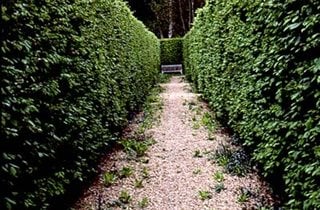
Photo by: Allison Harris.
The house — a low-slung modern building with a kitchen full of copper pans and a living room lined with Miró prints — overlooks what appears to be an untamed woodland, accented by camellias and tall pink foxgloves. Nature has had some help, however: A steep gravel path loops down between flowering shrubs and a mix of spontaneous and planted ground cover — primulas, violets, ivy, and cyclamen. Other, almost imperceptible dirt paths wind past spectacular rhododendrons, magnolias, cotoneaster, and cherry trees. “I don’t get too worried about gardens,” Rudkin says, “because I know they’re always accidental. There were a few camellias and rhododendrons on this slope when I bought the property, for instance. When I saw how well they were doing, I thought, I’ll just add more, little by little. That’s what brought me down the hillside.” When he first saw the field at the bottom, Rudkin recalls, “it was just junk — brambles, old mattresses, bedsprings. I cleaned it out and planted thousands of daffodils.”

Photo by: Allison Harris.
The path continues across the field toward an opening in a tall hornbeam hedge. It’s a shock to step through the hedge and into a space that is, in effect, a lobby. A leafy corridor leads past a small fountain into a series of garden rooms divided by walls of hornbeam and beech. One is a garden full of flower beds patterned with low, geometrically clipped boxwood. There are exuberant blue and white gardens, and a rock garden softened with wild strawberries and Fritillaria meleagris. “I put in big flowering plants that foam and explode and fall to the ground,” says Rudkin. “I like to use large blocks of color and not get them all mixed up together like scrambled eggs.” Another garden is a paved area to display containers in summer, while still another holds only a 16th-century stone wellhead surrounded by gravel. Rudkin’s inspiration here, he says, was the garden at Sissinghurst in Kent, the home of Sir Harold Nicolson and Vita Sackville-West. “Everything is crooked, nothing straight,” he says admiringly, “and yet Nicolson was able to pull everything together.”
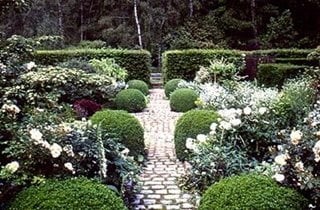
Photo by: Allison Harris.
One friend of Rudkin’s who admired his garden was Mary Sargent Ladd, the Baroness d’Anglejean, a board member of the Franco-American museum at Château de Blérancourt in Picardy — and in 1989 she gave him his first public commission, to design a garden at the château. He did this by transforming what had been a vegetable patch into two intimate walled gardens with great sweeps of color and, appropriately enough, mostly American plants—among them cosmos, dahlias, marigolds, asters, heliotrope, and the plant that has become Rudkin’s signature, Verbena bonariensis. (“You never saw it in Paris until I used it at the Palais Royal,” notes Rudkin, “and now it’s everywhere.”)

Photo by: Allison Harris.
Three years later, when American art collector Daniel Terra founded the Musée d’Art Américain in Giverny, Rudkin was asked to create a garden there, too. The museum, a discreet limestone-clad building terraced into surrounding hills, abuts fields once painted by Giverny’s most famous resident, Claude Monet — so Rudkin left one side of the garden unhedged and turned an adjoining area into a field strewn with poppies. The old gardens on the museum property were littered with bristling metal frames; Rudkin converted them into arbors for white wisteria (“a polite nod to Monet, who’s next door”) and constructed another series of garden rooms, this time packed with Japanese anemones, cosmos, heliotrope, and morning-glories. Like all his gardens, it is wonderfully democratic — accessible, easily enjoyable, filled with fragrant, unpretentious plants.
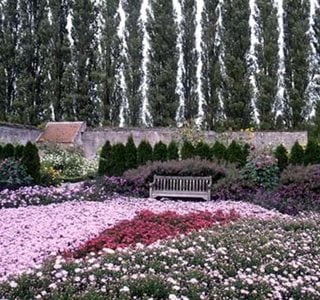
Photo by: Allison Harris.
Rudkin’s advice to other gardeners is plain and simple: “Make a list of what grows well in gardens around you and make your garden out of that. If one plant does very well, plant more of that, and if another doesn’t do well, take it out.” There is a certain New England bluntness to his advice—but Rudkin resists any attempt to see his gardens as a blend of French sophistication and American practicality. “They come from the experiences I’ve had looking at gardens of all kinds in many countries,” he says. “I certainly wouldn’t give them a nationality.” It’s surely just a coincidence, then, that the tallest flower in the blue garden at Rudkin’s house in Le Mesnil St-Denis is a delphinium developed by another American artist (albeit by adoption) who loved Europe, Edward Steichen. Its name? Connecticut Yankee.
